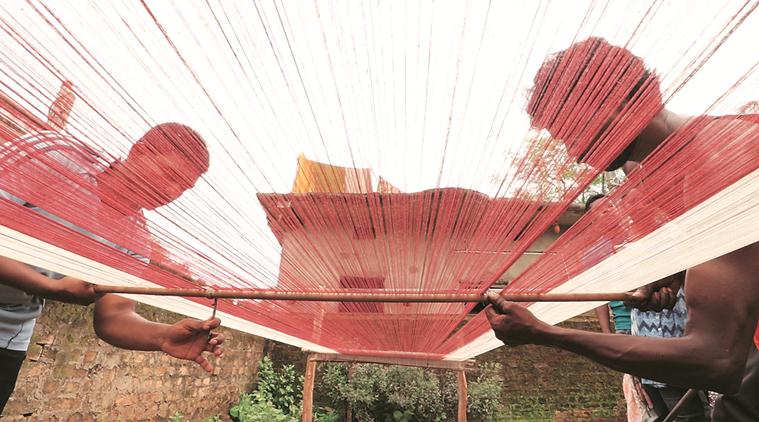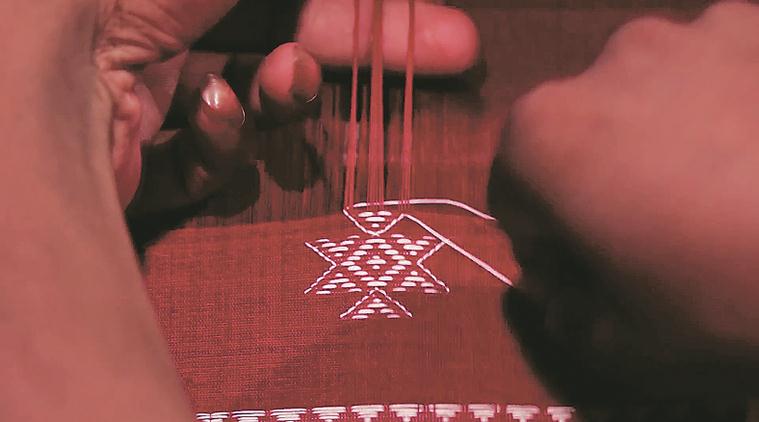
In the red: Kotpad handloom and its ties with nature, tribal rituals
Related News [hhmc] A still from the film Kotpad Weaving: The Story of a Race Against Time. Kotpad,..
Related News
 A still from the film Kotpad Weaving: The Story of a Race Against Time.
A still from the film Kotpad Weaving: The Story of a Race Against Time.Kotpad, located to the south of Odisha, is famous for a tribal textile — red and brown dyed handloom fabric, slightly rough to touch, made by the Mirgan community since time immemorial. Filmmaker Biswanath Rath, who was born and grew up 40 km kilometres away, in Jeypore, in the same Koraput district, had never heard of Kotpad handloom until 2016. A mechanical engineer, who quit Maruti Udyog Ltd to study filmmaking, Rath is drawn to stories and, now, he heard the call of a little-known textile that is an heirloom of an ancient past. His short film on the subject, titled Kotpad Weaving: The Story of a Race Against Time, is considered the first on the subject. It has been screened at 14 film festivals, including Ambacht in Beeld Film Festival 2019 in Amsterdam that focuses on art and craft.
Advertising
“It was a journey that began when I read in an article that singer Sona Mohapatra had worn Kotapat handloom on the ramp at the Amazon Fashion Week 2016 in Delhi. I was curious. What is Kotapat handloom? I made a call to my parents because my family has lived in the region for seven to nine generations. I was shocked when they, too, did not know about Kotpad textiles. I enquired in my town level and at the district level. Hardly anybody knew. I realised that this was a story that needed to be told,” says Rath, 34, who is based in Pune.

 From the beginning, the film establishes the textiles close ties with nature and tribal rituals.
From the beginning, the film establishes the textiles close ties with nature and tribal rituals.At the time, Rath had made short films such as Kar Bhalaa, based on a real-life situation in which the series House of Cards inspires a man, who has been looked over for a promotion, and The “Right” Glass, a 90-second film without dialogues, about child labour. He was searching for a subject on the theme, “Made Only in India”, to make a film with the Delhi-based Public Service Broadcasting Trust. Kotpad weaving seemed suitable. His journey to Mirgan Street in Kotpad, home to the weavers, was a reminder of what has been lost — a colourful culture that revolves around nature — and what may die soon. “I was shocked to see that most weavers are above 60. This is a hereditary practice and, if it is not taken up by the next generation, how will it survive?” asks Rath.
From the beginning, the film establishes the textiles close ties with nature and tribal rituals. Scholars talk about the textiles sociocultural importance, as the film elaborates the process of weaving and dyeing that may take 30 days, and involves boiling the roots of the Aal (Indian Madder tree) that once grew plentiful in the region and now, due to deforestation, has to be sourced from another district, Kalahandi.
Advertising
“The lifestyle of the tribes has emerged from nature. The colours of the fabric are obtained from organic sources, such as Aal, castor oil, wood ash and cow dung. Antique pit looms are used to produce awe-inspiring patterns of nature-inspired tribal motifs. The increasing price, scarcity of raw material and popularity of synthetic fabric, is threatening this tradition. My film seeks to create awareness of the crises faced by Kotpad handlooms and we should address certain issues immediately,” says Rath, who attended LV Prasad Film and TelevisioRead More – Source

